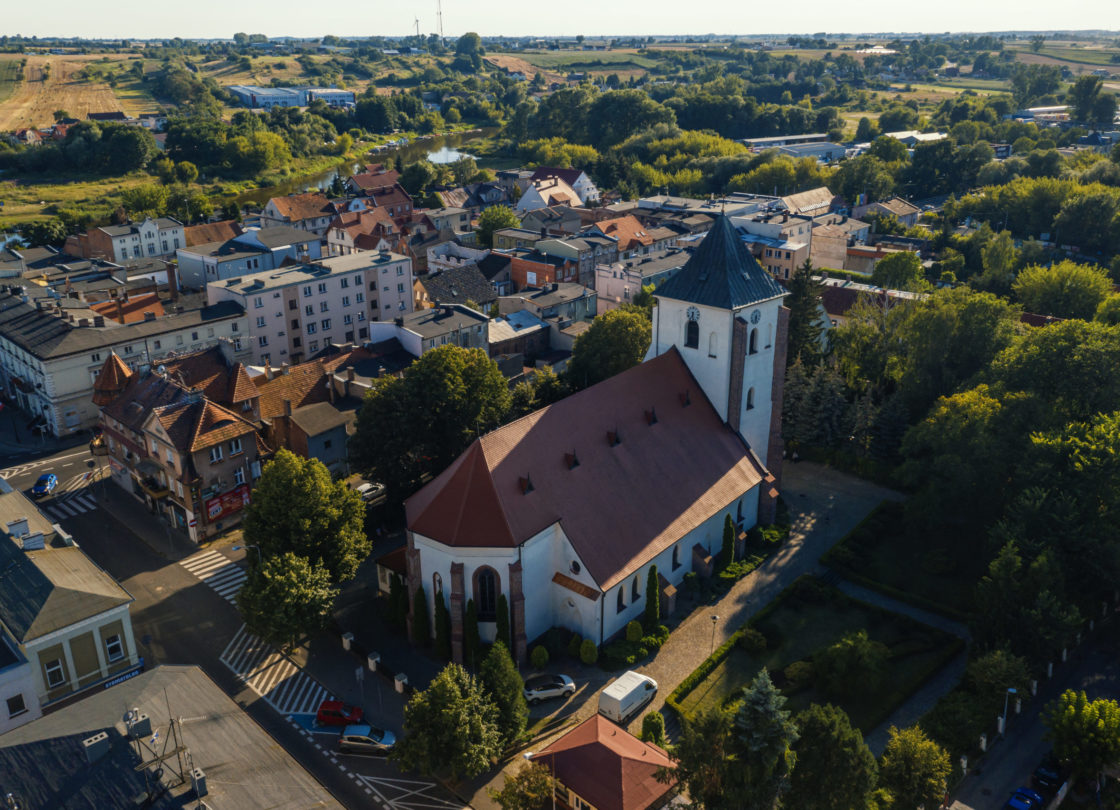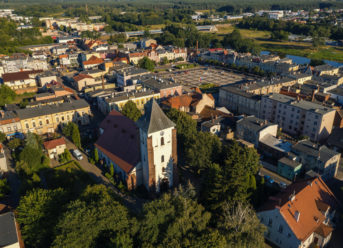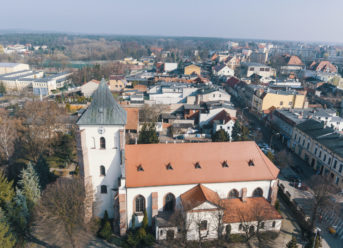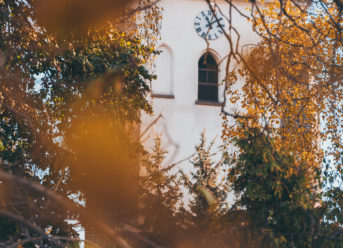Kościół pw. NMP Wniebowziętej
Die Kirche der Himmelfahrt der Allerheiligsten Jungfrau Maria in Oborniki
Parish Church of the Assumption of the Blessed Virgin Mary
Fara znajduje się przy Rynku. Historyczne zapisy informują, że w XV-XVI w. wzniesiono kościół gotycki z cegły, pw. Najświętszej Maryi Panny Wniebowziętej. Budynek kościelny przeszedł w swej historii kilkakrotne zniszczenia i pożary – między innymi w 1655, 1757 oraz 1814 roku. Następstwem tych zniszczeń jest niska, kwadratowa wieża, kryta dachem namiotowym i krycie wnętrza stropem w miejsce dawnego sklepienia (od roku 1815). W drugiej połowie XVIII wieku dobudowano od strony południowej kaplicę Matki Boskiej Różańcowej. Portale z cegły profilowanej, częściowo wymienionej, gotyckie ostrołukowe z XV/XVI wieku. W kruchcie, pod wieżą, krata kuta, żelazna z XVIII wieku. Ołtarz główny murowany, późnobarokowy z drugiej połowy XVIII wieku z obrazem przedstawiającym Wniebowzięcie Najświętszej Maryi Panny z XVIII/XIX wieku, przemalowanym w 1926 roku.
Na wieży od 1986 roku znajdują się 3 dzwony: „Wniebowzięta” – 750 kg, „Jan Paweł II – Papież Polak” – 520 kg, „Św. Kazimierz” – 360 kg. Od 26 czerwca 2012 r. na Ołtarzu Wystawienia Najświętszego Sakramentu znajdują się relikwie świętego Jana Pawła II.
Przy wejściu do kaplicy Matki Boskiej Różańcowej, umieszczona jest figura św. Antoniego Padewskiego (XVII w). Natomiast w samej kaplicy w ołtarzu znajduje się obraz – płaskorzeźba Matki Boskiej Różańcowej w wieńcu piętnastu malowanych scen z tajemnicami różańca św. (II poł. XVII w).
Na terenie przykościelnym od strony północnej znajduje się figura Najświętszego Serca Pana Jezusa – 1950 rok; od strony południowo zachodniej – grota Matki Bożej z Lourdes.
Od 2019 roku, kiedy to Oborniki obchodziły jubileusz 680-lecia, punktualnie o godzinie 12.00 z kościelnej wieży rozbrzmiewa miejski hejnał.
Die Pfarrkirche liegt in der Nähe vom Marktplatz. Laut den historischen Quellenangaben wurde die ursprüngliche gemauerte Kirche um die Wende vom 15. zum 16. Jh. aufgebaut.
Seit dieser Zeit wurde sie mehrmals zerstört und verbrannt - unter anderen in den Jahren 1655, 1757 und 1814. Infolge der Beschädigungen wurde der rechteckige Turm umgebaut. Der heutige Turm ist mit einem Zeltdach gedeckt. Infolge der Zerstörungen musste auch das ehemalige Gewölbe mit einer Decke ersetzt werden. Von dem ursprünglichen Gebäude blieben spitzbogige Fenster aus dem 15./16. Jh. erhalten. Im Kirchinneren ist die Kapelle der Muttergottes vom Rosenkranz besonders sehenswert. Sie wurde erst in der zweiten Hälfte des 18. Jhs. an der Südseite der Kirche zugebaut. Aus gleicher Zeit stammt ein eisernes Gitter, das sich in der Vorhalle befindet.
Der zweifellos größte Kunstschatz steht im Mittelpunkt der Kirche - der gemauerte Spätbarockalter aus der zweiten Hälfte des 18 Jhs. mit einem wertvollen Gemälde der Maria-Himmelfahrt. Von dem originalen Kunstwerk wurde 1926 eine Kopie errichtet.
Im Glockenturm gibt es drei Glocken: Maria-Himmelfahrt-Glocke - 759 Kilogramm, Johannes Paul II.- Papst-Pole-Glocke - 520 Kilogramm und St. Kasimir-Glocke - 360 Kilogramm schwer.
Am 26. Juni 2012 bekam die Gemeinde Reliquien von dem Papst Johannes Paul II. überreicht. Das Reliquiar befindet sich auf dem Alter des Allerheiligsten Sakraments. In der Kapelle der Muttergottes vom Rosenkranz befindet sich ein großartiges Relief, das die Muttergottes Maria im Kreuz von 15 Szenen von den Rosenkranzgeheimnissen darstellt. Das Werk stammt aus der zweiten Hälfte des 17. Jhs.. Vor der Kapelle wurde die aus der gleichen Zeit stammende Statue des St. Antonius Padewski angebracht.
Neben der Kirche befinden sich die Statue des Allerheiligsten Herzens Jesu (an der Südseite) und die in Form einer Grotte erbaute Kapelle der Muttergottes von Lourdes (an der südwestlichen Seite).
Seit dem Jahre 2019 ist täglich um 12.00 Uhr vom Kirchenturm ein Trompetensignal (Hejnał) zu hören - anlässlich des 680. Jubiläum von Oborniki.
Parish Church of the Assumption of the Blessed Virgin Mary Fara (Fara means the oldest church in town or the seat of Deanery) is located next to the town square. Historical records show that a brick Gothic church of the Assumption of the Blessed Virgin Mary was erected in between 15th and 16th century. The church building has suffered from damage and fires several times in its history including 1655, 1757 and 1814. As a consequence of these events a low, square tower, covered with a tent shape roof was built and a wooden ceiling in place of the former vault (since 1815). In the second half of the 18th century the chapel of Rosary Mother of God was added on the southern side. Portals made of profiled brick, partially replaced, Gothic sharp-edged brick from the 15th and 16th century. In the porch, beneath the tower you can find a hammered, iron grating from the 18th century. Late Baroque brick main altar from the second half of the 18th century with a painting depicting the Assumption of the Blessed Virgin Mary from the 18th/ 19th century, repainted in 1926.
The tower has had 3 bells since 1986: "Assumption" - 750 kg, "John Paul II – Polish Pope" - 520 kg, "St. Casimir" - 360 kg.
Since 26 June 2012, the Altar of the Exhibition of the Blessed Sacrament contains the relics of St. John Paul II.
At the entrance to the Chapel of Our Lady of the Rosary, there is a statue of St. Anthony of Padua (17th century). In the chapel itself, in the altar, there is a painting - bas-relief of Our Lady of the Rosary in a wreath of fifteen painted scenes with the mysteries of the Holy Rosary (second half of the seventeenth century).
On the northern side of the church there is a statue of the Sacred Heart of Jesus Christ - 1950; on the south-west side there is a cave of Our Lady of Lourdes.
Since 2019, when the city of Oborniki celebrated its 680th anniversary, the city bugle call has been sounded every day from the church tower at 12.00 on time.






